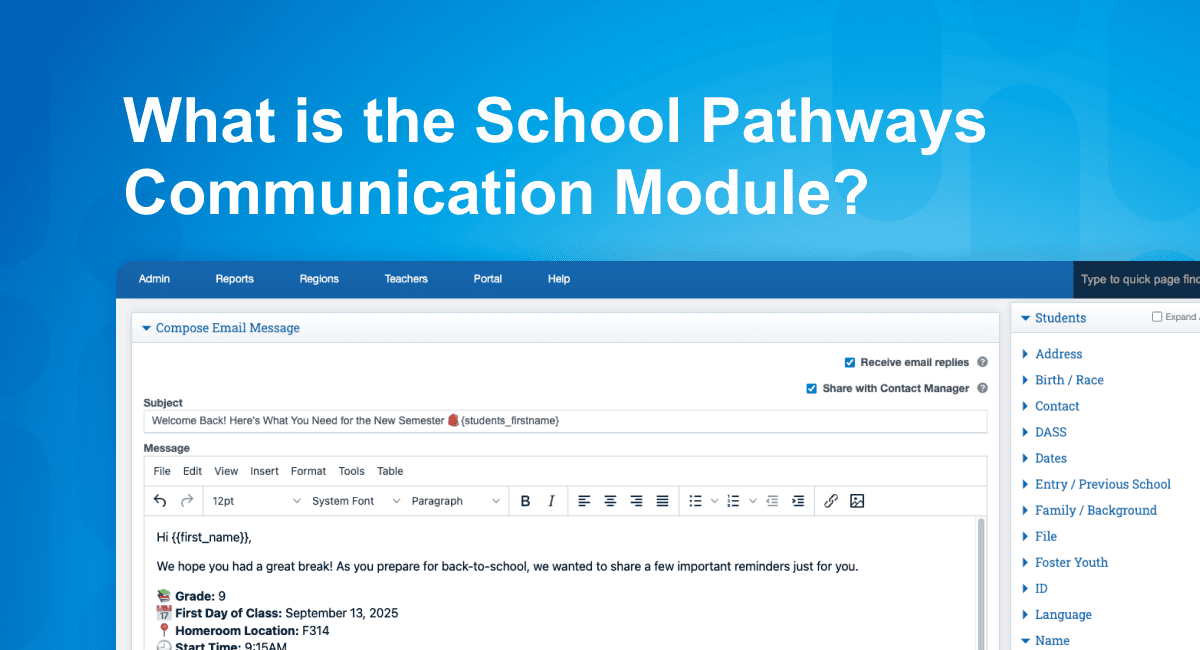Increased interest in Independent Study (IS) is here to stay. That became evident when learning environments had to shift due to the COVID-19 pandemic, and it’s even more true now with California’s AB 130, AB 167, and now AB 181 mandating that every CA district offer an Independent Study option while placing new, complex requirements on IS as a whole.
With this wave of students and families seeking alternatives to the traditional classroom environment, many education leaders are looking for best practices, tools, and technology to help them successfully grow an Independent Study program.
That’s why we’re here to share eight practical tips to guide your way—whether you’re building a new IS program or expanding an existing one.
At School Pathways, we’ve spent 20+ years helping educators master Independent Study from set-up and instruction to compliance. We pulled together learnings from our own experiences and our expert customer base to develop these time-tested tips for managing IS.
1. Create an Accessible Toolkit with Online Learning Platforms
It’s essential to make sure that your students and families have easy access to all courses, materials, grades, and any other touchpoints for engagement. A good way to address this is by assessing your program needs and building a toolkit of online platforms.
Facilitating learning through centralized, online platforms provides streamlined access and helps eliminate missed messages, delays in learning, and overall confusion.
It’s also key to recognize that internet access itself can vary, so you may need to do home checks and provide hotspots or other equipment to families to ensure that students have access to everything they need.
2. Outline and Simplify Your Pathway for Family Communications
Having a support system at home to help provide oversight and check-ins is a core aspect of Independent Study.
Now, with AB 130, there are additional requirements, including tiered re-engagement communications to family if a student is absent for three days in a row or 60% or more of the school week as a whole. The best thing you can do here is to create email templates and established workflows for re-engagement practices, even beyond what’s required to be outlined in the board policy section of your Master Agreements.
The more you can streamline communications and organize the process of who does what, when, the easier time everyone will have—and the more these communications will serve their purpose of keeping students engaged and on track with their learning.
3. Establish a Proactive Relationship with Your Auditor
While the guidelines for Independent Study include in-depth specifics, there is still some variation in how certain requirements get applied in practice. This is why one of the biggest pieces of advice for IS is to establish a relationship with your individual auditor—and the sooner, the better.
You are all working toward the same mission of ensuring positive, productive education. So work together, pro-actively, to confirm that certain forms of documentation and reporting formats will match what your auditor is looking for.
Don’t be afraid to ask clarifying questions and customize to your auditor (within reason). Aligning on expectations will simplify your compliance and auditing process, minimizing stress and allowing you to put more time and focus on other matters.
4. Invest in Technology to Streamline Management and Scale with Ease
One big pain point for Independent Study programs facing new growth is how to manage more students and more cumbersome requirements without overburdening staff or negatively impacting students’ experiences. Investing in technology to specifically streamline program management and compliance is a key way to address that.
By bringing processes like master agreement management, student activity tracking, and attendance verification online, you can simplify the work required of teachers and administrators and actually enable your program to grow enrollment while reducing the time needed to oversee operations.
5. Be Intentional (And Flexible) About Organizational Structure
It’s important to establish an organizational structure that will best serve your staff and students. IS programs need to be uniquely cognizant of what teachers have the necessary qualifications for each subject while also arranging the Teacher of Record to oversee a student’s learning as a whole. Striking that balance is even more tenuous now that AB 130 has established additional asks around opportunities for live interaction and synchronous learning.
Know that there’s also not a one-size-fits-all solution. Some Independent Study programs work best with one teacher overseeing an array of courses for a mixed roster of students. Other programs have found their stride by having each teacher deliver the one or two subjects that they are most passionate about. There will naturally be some variation here based on grade levels as well.
The important thing is that you create a system that works for you and you are able to have some flexibility to shift as needed. Especially with changing Independent Study requirements and IS enrollment numbers are on the rise, leaving room to reflect and adapt will pay off in the long run.
6. Expand Students’ Life Skills by Teaching Time Management and SEL
Independent Study is a unique learning environment that requires initiative, self-awareness, and time management. Knowing that highlights a notable window of opportunity to support your students by going beyond the required curriculum and incorporating expansive life skills.
You can help students find their flow in Independent Study by guiding them to identify their own strengths and areas for growth and providing them a framework to intentionally practice time management.
You can even take it a step further by incorporating Social-Emotional Learning into your program so that students can develop self-management, improve decision-making, and build positive relationships.
By nurturing these life skills and approaching students holistically, you will help them navigate their coursework as well as the larger ups and downs in life.
7. Nurture Your Program Culture and Community
Because Independent Study is primarily personalized, often physically separated, learning intentionally nurturing a larger program culture helps students feel part of a community with a more extensive support system and among peers they can relate to.
An excellent way to get started on this front is to share updates and stories about staff and students through a regular newsletter or posting on social media. Providing a path for students to join sports teams or take music or dance classes and having a physical learning center for drop-ins are additional ways to build connections within Independent Study and achieve a palpable, unifying culture.
Or, for a high-level option, an alumni program to connect current students with graduates and even offer some post-graduation support is great for community building.
8. Always Return to Your Purpose
IS exists to provide an equitable education to those who might not feel suited to or aren’t able to work within a traditional learning environment. All of the changes during this pandemic have just reinforced the importance of offering Independent Study; ignoring or minimizing IS would leave a lot of students behind.
It’s also important to acknowledge the diversity of students who turn to IS, including their individual needs for flexibility or adaptation, and make sure that you are rising to the occasion.
Even with our other essential tips, centering your purpose—supporting your students in the various ways that they need—is the best gut check and motivator to hold with you.
Additional Resources for Independent Study
For other resources on how to run a successful Independent Study program check out:
- The California Consortium for Independent Study (CCIS) and their best practice webinars
- Virtual IS Toolkit from The California County Superintendents Educational Services Association (CCSESA)
- IS Overview for LEA Leaders from the Los Angeles County Office of Education.
As an IS leader, you are not alone, and we can all learn from sharing our experiences. School Pathways has been doing a lot of exciting work around Independent Study program management and compliance, and we would love to be a resource as your IS program grows.
If you’d like help problem solving or you’re interested in learning more about our unique software solution for Independent Study—we would love to chat!






